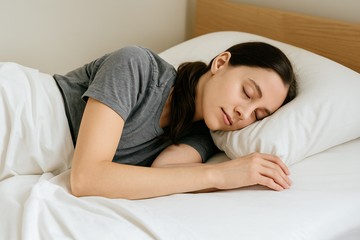Why You Should Consider Sleeping Grounded for Better Health

Do you ever wake up feeling unrested, achy, or stiff—even after a full night’s sleep? What if part of the solution lies in how you sleep, not just how long you sleep?
Grounding your bed—using grounding sheets or mats while you rest—introduces your body to Earth’s natural electrical energy all through the night. This simple practice may help with deeper sleep, reduced inflammation, better circulation, and more.
In this article, we’ll explore:
-
The scientific basis behind sleeping grounded
-
Health benefits you may experience
-
How to set up grounding in your sleep space
-
Tips to get started safely
The Science Behind Sleeping Grounded
The Earth is electrically active, and its surface carries a mild negative charge. When your body is in direct contact with the ground (or a conductive surface connected to it), electrons can flow from Earth into your body. This flow helps neutralize excess positive charges (free radicals) and can stabilize your body’s electrical environment.
Studies show that grounding may help lower inflammation, regulate cortisol rhythms, and decrease stress markers. For example, participants sleeping grounded have exhibited improved sleep and reduced pain in trials.
Key Benefits of Sleeping Grounded
Here are some of the advantages people report when they ground their bed regularly:
1. Deeper, More Restorative Sleep
Grounding helps synchronize your internal clock, regulate cortisol (your stress hormone), and calm your nervous system — all supporting better sleep onset and continuity.
2. Reduced Inflammation & Pain
By reducing oxidative stress and free radicals, grounding may help lower inflammation. Many users notice reduced aches, stiffness, or chronic pain, especially in joints and muscles.
3. Better Circulation & Blood Flow
Grounding has been associated with improved blood viscosity and circulation. Better blood flow means better nutrient and oxygen delivery to tissues while you rest.
4. Enhanced Immune Function
With lower inflammation and oxidative stress, your immune system can focus on recovery rather than constant damage control.
5. Stress Reduction & Mood Balance
Lower cortisol and more balance in your body’s electrical system translate to calmer moods, less anxiety, and enhanced emotional resilience.
How to Ground Your Bed
Putting grounding in your bedroom is simpler than you might think. Here’s how:
-
Choose a grounding sheet or mat
-
Sheets: These cover more surface area, ideal to ground the entire body during sleep.
-
Mats: Use under part of your body (for example, around your feet or torso) if you can’t use a full sheet.
-
-
Proper wiring
-
Connect the sheet or mat to a grounding outlet (the third prong).
-
If a grounded outlet isn’t available, use a grounding rod placed in the earth outside.
-
-
Ensure direct skin contact
-
Conductive fabric should touch your skin (arms, legs, body). Avoid insulating layers (like thick rubber soles or heavy non-conductive covers) between you and the sheet/mat.
-
-
Consistent nightly use
-
Use it nightly (or as often as possible). The benefits compound over time.
-
Monitor your body’s response and adjust usage gradually.
-
Safety & Practical Tips
-
Always follow manufacturer instructions for your grounding product.
-
Use only tested, certified conductive materials.
-
Start slowly: Some people feel slight “detox” responses initially (e.g. vivid dreams, mild fatigue) as the body adjusts.
-
Avoid combining grounding with devices that carry current or faulty wiring.
-
Clean and maintain your grounding sheet or mat as directed.
Final Thoughts
Sleeping grounded is an easy, low-effort habit you can integrate into your nightly routine. It bridges modern life with Earth’s natural energy, helping your body repair and regenerate while you rest.
Whether you’re struggling with sleep, inflammation, pain, or stress, grounding your bed may be the missing piece in your wellness puzzle.
👉 Check out our grounding bed sheets and mats bellow to bring this practice directly into your sleep space.




